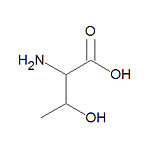Threonine: Difference between revisions
Jump to navigation
Jump to search

imported>David E. Volk (stub and structure) |
imported>Caesar Schinas m (Bot: Update image code) |
||
| Line 1: | Line 1: | ||
{{subpages}} | {{subpages}} | ||
{{Image|Threonine stick figure.jpg|right|150px|'''Threonine''', a common amino acid.}} | |||
'''Threonine''', abbreviated as '''Thr''' or '''T''', is one of the twenty common [[amino acid]]s used by living organisms to build [[protein]]s. It is one of the neutral, polar, [[hydrophilic]] amino acids. It is mostly exposed on the outer surface of proteins, but does have to be. Because it contains a hydroxyl group, OH, it is subject to [[phosphorylation]] by [[kinases]]. [[Serine]] and [[tyrosine]] are the only other amino acids with hydroxyl groups on their side chains. | '''Threonine''', abbreviated as '''Thr''' or '''T''', is one of the twenty common [[amino acid]]s used by living organisms to build [[protein]]s. It is one of the neutral, polar, [[hydrophilic]] amino acids. It is mostly exposed on the outer surface of proteins, but does have to be. Because it contains a hydroxyl group, OH, it is subject to [[phosphorylation]] by [[kinases]]. [[Serine]] and [[tyrosine]] are the only other amino acids with hydroxyl groups on their side chains. | ||
Revision as of 07:59, 8 June 2009
Threonine, abbreviated as Thr or T, is one of the twenty common amino acids used by living organisms to build proteins. It is one of the neutral, polar, hydrophilic amino acids. It is mostly exposed on the outer surface of proteins, but does have to be. Because it contains a hydroxyl group, OH, it is subject to phosphorylation by kinases. Serine and tyrosine are the only other amino acids with hydroxyl groups on their side chains.
